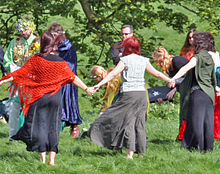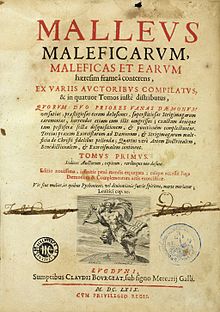Witch

Awitchis a person (oftenfemale) who practiceswitchcraft,magic or potions. In modern times, they have become characterised with pointed hats, black cloaks andbroomsticks.
Traditionally, the word “witch” was used as an accusation. Witches were accused of bewitching people, or casting spells to control them. In some societies, they were seen as evil, but in others, witches were viewed positively.

Today, followers ofWiccapractice witchcraft andworship nature.Some call themselveswitches.Note that the practitioners of Wicca are completely unrelated to the historical witches, this article is about.
History
[change|change source]Mostindigenous peoplesthroughouthistoryhave had some beliefs aboutspiritsand believed that certain individuals could gain magical powers throughherbsor spirits. However, these individuals were not called 'witches' until indigenous people had contact with western ideas. Spirits and people who interacted with them were not always viewed negatively in indigenous societies.
The Malleus Maleficarum
[change|change source]TheMalleus Maleficarum,a book published in 1487, fueledpanicover witchcraft.It was written by aGermanCatholicclergymannamed Heinrich Kramer. The book was a witch-hunting manual that explained how topersecutewitches. It suggested usingtortureto get accused witches toconfessto witchcraft. It also encouragedburning “witches” at the stake.
The newtechnologyof theprinting pressmade it possible forMalleus Maleficarumto bemass-produced.The book was printed 29 times before 1669 - more than any other book except theBible.As a result, its ideas spread throughout Europe. These ideas were common in Europe for severalcenturiesafter the book was published.
The book says that three things are needed in order to create witchcraft: the witch’s evil intentions, theDevil’shelp, andGod’spermission.[1]
Witch Hunts
[change|change source]Many women throughout Europe and inSouth Americawere killed by witch hunts. Historians debate how many women were killed. Because of poor record keeping, it is impossible to know exactly how many victims there were. Also, historians have different opinions about what regions and time frames should be included when estimating how many women were killed in witch hunts.
The entire persecuting legal system - "judges, ministers, priests, constables, jailers, judges, doctors, prickers, torturers, jurors, executioners" - were nearly all male. Meanwhile, the victims were overwhelmingly female. For this reason, some scholars call the witch hunts a "gynocide". In the documentaryThe Burning Times,Thea Jensen calls this period in history a "Women'sHolocaust".
Modern understanding
[change|change source]
In the20th century,many people made a new attempt to understand witchcraft. Some say that witches were in fact wise women who were hunted down by theCatholic Church- mostly for their knowledge about how to treat certaindiseasesusingherbs.Some followers ofpagan religionslike Wicca began to call themselves witches. This has led to a new understanding of what a “witch” really is.
Heather Marshhas tied the persecution of witches to the fight of church and industry to control "the power of life and death" at a time when industry needed more workers. She also argues the persecution of witches was a fight for centralized power over the peasant rebellions and the ownership of knowledge by medicine and science which forbade the earlier teaching or practices by women and indigenous cultures. She writes that the persecution of witches has colored misogyny since the 1400s.[2]
Silvia Federici tied the witch hunts to a history of the female body in the transition to capitalism.[3]
Witchcraft and accusations of witchcraft are still very common in some parts of West Africa.
Witch crimes in theMalleus Maleficarum
[change|change source]
Control ofprocreationwas a constanttheme,as wasmedical knowledge:
- Concerning Witches whocopulatewith Devils. Why is it that Women are chieflyaddictedtoEvilsuperstitions?
- Whether Witches may work some PrestidigatoryIllusionso thatthe Male Organappears to be entirely removed and separate from the Body.
- That Witches who areMidwivesin Various Ways Kill the Child Conceived in theWomb,and Procure anAbortion;or if they do not this OfferNew-bornChildren to Devils.
- How Witches Impede and Prevent the Power of Procreation.
- How, as it were, they Deprive Man ofhis Virile Member.
- Of the Manner whereby they Change Men into the Shapes of Beasts.
- Of the Method by which Devils through the Operations of Witches sometimes actuallypossessmen.
- Of the Method by which they can Inflict Every Sort ofInfirmity,generally Ills of the Graver Kind.
- Of the Way how in Particular they Afflict Men with Other Like Infirmities.
- How Witch Midwives commit most HorridCrimeswhen they either Kill Children or Offer them to Devils in most Accursed Wise.
Witches in films and stories
[change|change source]- Hocus Pocus,a film which is about three witches
- The Wizard Of Oz,a book/film which has a witch as the main villain
Famous people accused of witchcraft
[change|change source]- 1431:Joan of Arc.She was burned at the stake on 30 May.
- 1591:Elizabeth of Doberschütz.She wasbeheadedandburntoutside the gates ofStettin,on 17 December.[4][5]
- 1594:Maria Holl(also known asThe Witch ofNördlingen). She was one of the first women towithstandbeing tortured during her witch trial of 1593-1594. She was eventually cleared of the accusations, which led some people to doubt therighteousnessof witch trials. Through her force, Holl rid the town of Nördlingen of their witch craze. She died in 1634, probably from theplague.
- 1612:The Samlesbury witches.In August 1612, they were found not guilty in one of the most famous witch trials inEnglish history.However, ten other people were found guilty and werehanged.
- 1635:Hester Jonas(also calledThe Witch ofNeuss).She was beheaded and burnt on Christmas Eve in 1635, at about 64 years old. The complete proceedings of the trial are still available in Neuss.
- 1663:Anna Roleffes(better known asTempel Anneke). She was one of the last witches to be executed inBraunschweig.She was beheaded on 30 December.[6]
- 1680:Catherine Monvoisin,a lover ofLouis XIVwho was close toMarquise the Montespan.She deliveredpoisonsand heldblack massesfor payment. In 1680, she was burnt to death along with some other accused witches on thePlace de la GrèveinParis.
- 1692: The witches accused during theSalem Witch TrialsinSalem, Massachusetts.Today, Salem is called “the Witch City,” and historical sites related to the witch trials aretourist attractions.
- 1751:Anna Schnidenwind.She was one of the last women to be publicly executed for witchcraft inGermany.On 24 April, inEndingen am Kaiserstuhl,she wasstrangledto death, then burned.[7]
- 1782:Anna Göldi(or Göldin). She was the last witch to be executed in Europe. Her execution happened inGlarus,Switzerland,in the summer of 1782.
References
[change|change source]- ↑Russell, Jeffrey Burton (1972).Witchcraft in the Middle Ages.Cornell University Press. p.232.ISBN978-0-8014-9289-1.
- ↑Marsh, Heather (May 2014)."Witches and how they are silenced".
- ↑Silvia Federici 2004.Caliban and the Witch: women, the body and primitive accumulation.
- ↑Wehrmann, Martin (1979).Geschichte der Stadt Stettin.Weidlich. p. 264.ISBN978-3-8128-0033-4.
- ↑Branig, Hans; Buchholz, Werner (1997).Geschichte Pommerns.Böhlau. p. 158.ISBN978-3-412-07189-9.
- ↑Morton, Peter, ed. (2006).The Trial of Tempel Anneke: Records of a Witchcraft Trial in Brunswick, Germany.Barbara Dähms, translator. Ontario: University of Toronto Press.
- ↑Klaus Graf:Der Endinger Hexenprozess gegen Anna Trutt von 1751(2012)online.
Other websites
[change|change source]- Some historical notes on the witch-craze from the historian Trevor RoperArchived2008-07-22 at theWayback Machine
- Kabbalah On Witchcraft - A Jewish view (Audio)chabad.org
- Jewish Encyclopedia: Witchcraft
- Witchcraft in the Catholic Encyclopedia on (New Advent)
- Witchcraft and Devil Lore in the Channel Islands,1886, by John Linwood Pitts, fromProject Gutenberg
- A Treatise of Witchcraft,1616, by Alexander Roberts, from Project Gutenberg
- The Witches' Voice1997-2007 The Witches' Voice Inc
